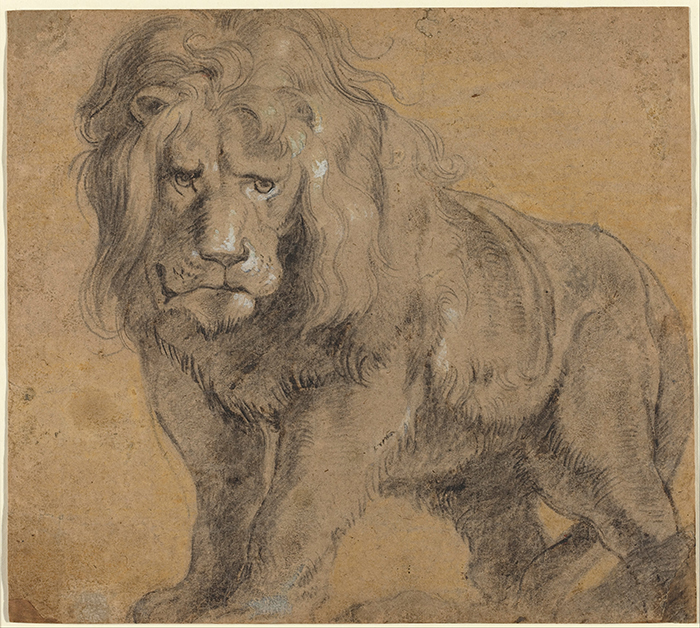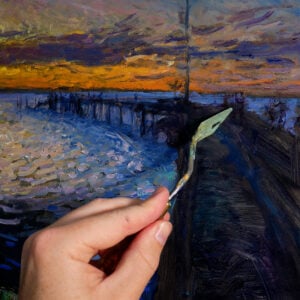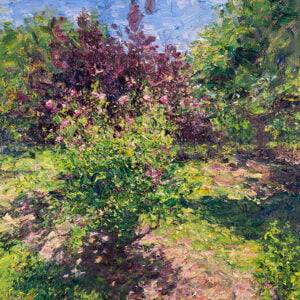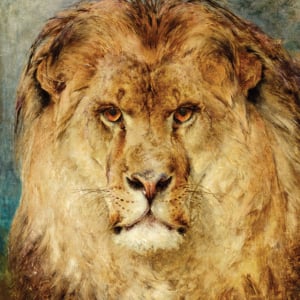Since Paleolithic times drawing has persisted as a multifaceted form of human expression. Particularly, as is the case with other media, drawing began to flourish as an independent art form during the Renaissance when artists created detailed studies of the human body. As time went by, drawing turned into a fundamental component of every artist’s creative process and was increasingly valued. In this article, we mention who are twenty of the most talented artists that mastered drawing and took it to unseen levels.
1. Sandro Botticelli (1445-1510)
Botticelli is a celebrated Renaissance painter who also produced many drawings. The artist’s 92 illustrations for Dante’s Divine Comedy are his most famous body of works as a draftsman but other studies he created for his paintings are also a testament to his working method. Dante’s book illustrations were left by the artist in different stages of completion and only a few of them are colored in tempera. Botticelli’s attempt to design the illustrations for a printed book was unprecedented for a leading painter and was not well-received during his lifetime. This illustration of the purgatory reveals Botticelli’s narrative abilities through the inclusion of synchronic scenes filled with movement and subtle contour lines.

2. Leonardo da Vinci (1452-1519)
Da Vinci was the ultimate Renaissance man. Next to creating masterpieces, studying the human anatomy, and inventing different machines, Leonardo was one of the first artists that used chalk as his primary material for creating preliminary studies and registering his observations of nature and science in multiple sketchbooks. Among his most famous drawings are the ones depicting the inner and outer structures of the human body. Without a doubt, the drawing known as The Vitruvian Man (1490) is Da Vinci’s most popular portrayal of the human figure which he considered to be a microcosm of the whole universe.

3. Albrecht Dürer (1471-1528)
Dürer was a gifted draftsman. Many of Dürer’s drawings were preliminary studies for his prints or paintings and also documented his travels across Italy and the Netherlands. Over time, Dürer created four self-portrait drawings and paintings which reveal the narrative the artist built around his talents. Interestingly, the portrait drawing Dürer sketched at age 13 that we see here is considered to be one of the oldest self-portraits in European art. It is said that this silverpoint drawing was a task that Albrecht the Elder asked for as a challenge for his son. It was signed at some unknown later date with the words: “This I drew myself from a mirror in the year 1484 when I was still a child. Albrecht Dürer.” In the image, the artist has a childlike nature but keeps a solemn and intellectual pose.

4. Michelangelo (1475-1564)
Next to his mastery of painting, sculpture, and architecture, Michelangelo was an accomplished draftsman. Before each painting and sculpture, the artist created numerous preparatory chalk sketches that evidence his working process. While most of his drawings captured only a few elements of the final artwork, others have finer detail and reveal a deep understanding of the human anatomy presenting it in complex postures. The preparatory study for the Libyan Sibyl in the Sistine Chapel evidences the artist’s talents. Here, we see the voluminous female figure from different viewpoints and we appreciate her profile, feet, and hands with extraordinary detail.

5. Raffaello Sanzio da Urbino (Raphael) (1483-1520)
Raphael was a talented draftsman. Even if the artist ran a studio filled with many assistants, he executed most of his drawings. The majority of the artist’s drawings were made with red and black chalk but he also worked with metalpoint, pen, and ink. One of Raphael’s favorite topics was the common trope of Madonna and Child, and he often created many drawings studying the same body parts or gestures. Interestingly, as well as drawing from life, Raphael created drawings of the sculptures he admired. A fine example of the artist’s drawing technique is this sketch of Hebe and Proserpine, which was a preparatory study for a fresco. In this work, the curved nature of the female figure is accentuated by Rafael’s portrayal of shadows and a foreshortened portrait.

6. Hans Holbein the Younger (1497-1543)
Hans Holbein the Younger is known for his paintings but he also created many preparatory sketches. Like many other artists, Holbein primarily sketched with chalk next to metalpoint and ink. One of the biggest commissions the artist received as an illustrator was the one of Publisher Johannes Froben who requested the artist to illustrate several upcoming books by Sir Thomas More and Desiderius Erasmus. Holbein was also sought after by the Tudor Court of Henry VIII and created drawings of the King and members of the nobility. He once was asked to travel to Europe to make portraits of potential brides for Henry VIII. This 1527 portrait of the Archbishop of Canterbury exemplifies the artist’s drawing skills as it captures the age and tired look of the sitter.

7. Peter Paul Rubens (1577-1640)
During the seventeenth century, Peter Paul Rubens was the most influential Baroque artist in northern Europe. Over the years, the artist created many drawings which served as a step toward a final work of art, such as a painting, illustration, or sculpture. The artist kept his drawings from the public eye given they were considered a studio secret and in his will even declared they were to be sold until it was clear that none of his children would become an artist or marry one. One of the artist’s most famous drawings is his realistic rendition of a lion constructed with black chalk and heightened with white and yellow in the background. This drawing was one of the studies for the painting Daniel in the Lions’ Den.

8. Charles Le Brun (1619-1690)
For some years Charles Le Brun was the most powerful artist in France given his complete control of the army of artists that worked for Louis XIV. As part of his artistic practice, Le Brun created many preparatory drawings for his classical paintings and sculptures, many of which adorned Versailles. He also developed a theory for the representation of the expressive potential of the human face. Drawing from René Descartes’ ideas, Le Brun believed the passions of the soul measurably affected the muscles of the face and created a coded visual language for the portrayal of emotions. The drawing that we see here reflects the effect that different types of emotions have on the human gaze mainly through the variations of the subject’s eyebrows.

9. Jean Antoine Watteau (1684-1721)
Watteau was a talented draftsman and used his sketches to prepare his paintings. While the artist produced between 2,000 to 4,000 drawings, fewer than 700 survive. Notably, the artist frequently used the same study in more than one oil painting and mastered the technique known as aux trois crayons, characterized by combining red, black, and white chalks. His distinctive style with this technique influenced other French artists during the eighteenth century. After 1714 Le Brun also created drawings with graphite, introduced in France around that time. The artist created the study of a female head that we see here with three colors of chalk that grant the sketch depth, volume, and an expressive nature.

10. Elisabeth Louise Vigée Le Brun (1755-1842)
Elisabeth Louise Vigée Le Brun was Marie-Antoinette’s favorite artist and painted more than 20 portraits of the Queen, some of which are drawings. However, with the advent of the French Revolution, Vigée Le Brun fled France and spent the rest of her life in Italy raising her daughter by herself and finding new patrons in foreign courts and among fellow royalist sympathizers. Only a few of Le Brun’s drawings survive, but they depict the artist’s mastery of the medium. Among them is the drawing she made of Marie Antoinette in a garden. Here, the artist portrayed the Queen wearing fashionable attire in an almost theatrical posture. This flattering portrait is a perfect example of why this artist was a successful court portrait artist.

11. Jean-Auguste-Dominique Ingres (1780-1867)
Neoclassical artist Jean-Auguste-Dominique Ingres is widely known for his oil paintings. However, the artist often created hundreds of preliminary drawing studies for each painting and also produced graphite portraits that captured the subject’s physical appearance and personality. Interestingly, Ingres valued drawing as a creative expression, something not so common during his time. He once said “…Drawing does not consist merely of line: drawing is also expression, the inner, form, the plane, modeling. See what remains after that.” The drawing titled Portrait of Madame Augustin Varcollier, née Atala Stamaty is a great example of Ingres’s mastery of drawing and of his ability to capture the subject’s traits with defined contours achieved with various types of lines.

12. Rosa Bonheur (1822-1899)
Rosa Bonheur achieved international fame with her impressive depictions of animals. She was the daughter of Raymond Bonheur, a liberal drawing master who had Rosa as his apprentice. Bonheur lived an unconventional lifestyle for her time as she was financially independent, wore male garments, and remained single. As part of her working process, Rosa made thousands of sketches of the animals she portrayed in her large-scale paintings. In this highly detailed drawing of a flock of sheep made with a brown wash over graphite, one can appreciate her ability to capture the animals’ positions, anatomy, and movement through overlapping delicate lines and bold traces.

13. Edgar Degas (1834-1917)
Edgar Degas was an Impressionist sculptor and painter who was an enthusiast of the female body. Alongside his celebrated oil paintings, Degas’s drawings and pastels captured the artist’s style and his favorite themes. For a while, the artist depicted family or friends, but starting in the 1870s focused on creating thousands of drawings of ballet dancers and other performers. Degas’s sketches bring forth his powers of observation as they explore the movement of the human body through the depiction of contorted postures and unexpected vantage points. This preparatory drawing for a wax sculpture presents us with three angles of the same dance posture executed by Marie van Goethem, a teenage dancer the artist frequently represented.

14. Mary Stevenson Cassatt (1844-1926)
Cassatt is the only American artist officially associated with the Impressionist movement and was the protégée of Degas who largely influenced her style. Consequently, Cassatt’s drawings captured family members and theater scenes and later on depicted mainly mother and child themes with a warm feeling and naturalistic approach. Often, some areas of the artist’s drawings are left bare, and the attention of the artist is set to the subjects’ faces capturing their emotions. This 1895 sketch shows Cassatt’s approach to drawing as it presents us with a detailed rendition of the mother and child’s facial expressions while their bodies are outlined with scarce traces.

15. Vincent Van Gogh (1853-1890)
Vincent Van Gogh is widely known for his oil paintings. However, he also produced 1,100 drawings and considered this medium fundamental for his practice describing it “as the root of everything.” Over the years, Van Gogh used drawing to practice his skills or to capture an impression. The artist also made many drawings of his paintings to provide his brother, Theo, with an idea of his latest creative endeavors. At the same time, Van Gogh frequently drew landscapes that, while constructed with subtle lines, uncover his distinctive expressive and gestural style. For instance, in the drawing titled Rock and Ruins, at Montmajour, the artist captured one of his favorite spots in Arles, France, from which he created a series of drawings with pencils, ink, and pen.

16. John Singer Sargent (1856-1925)
A famous oil painter, Sargent was also a talented draftsman and, starting in 1907, focused on producing charcoal portraits of intellectual personalities and members of high society. While this body of 750 works is often underrecognized it constitutes a fine example of the artist’s ability to represent the psychological traits of his subjects and his mastery of the chiaroscuro technique. Sargent often completed these portraits in a few hours and afterward moved on to the next commission. The portrait of Eugenia Errázuriz, the wife of a Chilean landscape painter, is a testament to Sargent’s ability to capture his subject’s traits through vigorous traces and subtle finishing touches.

17. Gustav Klimt (1862-1918)
Next to being the face of Vienna’s Secession movement Gustav Klimt was also a master draftsman who influenced the next generation of European artists. Over his career Klimt created more than 4,000 drawings some of which were preparatory studies for his portrait oil paintings of society women and for the many frescoes he painted. Notably, the majority of the artist’s drawings portrayed the female figure and revolutionized the depiction of nudes by including uninhibited erotic scenes and taboo sexual topics for the first time. Some of Klimt’s drawings are so explicit that to this day they are seldomly exhibited. The sketch titled Naked Girl with ruff lying constitutes a fine example of Klimt’s drawing style. In this work, Klimt used pencil and colored the subject’s lips in red to accentuate her sensuous nature.

18. Käthe Kollwitz (1867-1945)
Käthe Kollwitz is known for her drawings, woodcuts, paintings, and sculptures depicting suffering, war, and social injustice scenes which the artist witnessed firsthand through the work of her physician husband. Next to these heartbreaking scenes, Kollwitz created more than 100 self-portraits, many of which were drawings. In all of her sketches, the artist emphasized both the faces and hands of her subjects as a means to convey the raw emotions they were experiencing. For instance, in this self-portrait, the artist’s face is constructed with gestural lines set against an empty background as if hinting at the artist’s loneliness or despair.

19. Egon Schiele (1890-1918)
During his brief life, Egon Schiele developed a distinctive style of figurative portraiture characterized by expressionistic linework and the portrayal of exaggerated or distorted proportions of the human body. Egon worked at a frantic pace and created 3,000 drawings and watercolors, some of which are self-portraits and others are sketches of people he knew, such as his family and lovers. Occasionally, the artist also featured young prostitutes from the streets of Vienna. One of Schiele’s favorite models was his wife Edith, who he captured over the years in different drawings and paintings. An example of such a portrait is the one we see here constructed with bold and scarce lines that reflect the sitter’s expression and state of mind.

20. Pablo Picasso (1881-1973)
Pablo Picasso is known for changing his painting style over the years and for innovating in all the media he experimented with. Throughout his career, Picasso recurred to drawing as a means to create his paintings and sculptures and as a tool to convey his emotions and ideas in sketchbooks or even napkins. With only a few bold lines made with pencil, pen, or chalk, the artist captured the forms and expressions of his subjects. For example, Picasso’s famous drawings of his beloved dog, a dachshund called Lump, were constructed with a simple contour line that brings to life the distinctive traits and lively character of his pet.
Key Takeaways
- During the Renaissance Italy was the epicenter for the development of proportion and perspective theories that marked the course drawing took during the following centuries.
- France has a strong tradition of drawing artists given the academic instruction that flourished in the region was based on the mastery of this medium.
- The adoption of chalk during the Renaissance enabled a broader manner of drawing and was used as the primary drawing material for centuries.
- During the eighteenth century, the invention of the pencil also marked a breakthrough in the history of drawing as it brought more immediacy and subtle line variations to the medium.
- Due to the fragile nature of paper, only a small portion of drawings have survived to this date. Nonetheless, they are a testament to the creative process of each artist and are now valued as artworks in their own right.
Want to Learn More?
You might be interested in my Painting Academy course. I’ll walk you through the time-tested fundamentals of painting. It’s perfect for absolute beginner to intermediate painters.
Thanks for Reading!
I appreciate you taking the time to read this post and I hope you found it helpful. Feel free to share it with friends.
Happy painting!
Dan Scott

Draw Paint Academy






